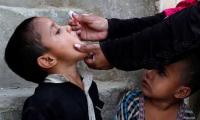Haji Muhammad Shafi, the then chairman of the union committee of Wilayatabad — a small settlement in the Golimar neighbourhood of Karachi’s District West — and Abida Sultana, the then education officer, were taking a stroll in the area in 1966 to find a location to set up a school for hundreds of out-of-school refugee children, who along with their families had settled there soon after Partition.
During their search, they noticed an unusual mud hill in the middle of the locality. They thought that they could build a school there if they levelled the mount, but when they began, they unearthed a hidden arms and ammunition depot of the British Indian Army.
In the early 1950s the then Karachi Municipal Corporation (KMC), with the efforts of Nawabzada Wilayat Ali Khan — who was the eldest son of Nawabzada Liaquat Ali Khan — had settled several colonies, including Hasrat Mohani Colony, Wilayatabad, Jahan Colony, Asif Colony, Pak Colony and Jauhar Colony, to settle refugees in the nearby open space of Golimar.
“At that time Golimar was in the outskirts of Karachi city. And some writers and historians claim that Golimar was once a training centre of the British Indian Forces, most probably in the late 19th century,” said 70-year-old Manzoor Ahmed, who is the eldest son of Haji Muhammad Shafi.
“I was not much older, but I still remember that five to six trucks of the Pakistan Armed Forces entered our area to clear the ammunition from the site. After discovering a building full of weaponry and a small office, the army personnel took inventory and loaded the ammunition in those trucks.”
Later, the education officer and the KMC official visited the area to set up the school in the building without demolishing it. However, the basements built under the arsenal building were sealed off with soil and concrete. Since then, the school is known as the Barood Khana Government School, functioning under the District Municipal Corporation (DMC) West, now Keamari.
“In the last six decades, thousands of children have studied at the Barood Khana School. However, after the mushroom growth of private sector schools and the failing quality of education at the state-run school, now parents prefer not to enrol their children there,” said Ahmed.
“I studied at the Government High School Firdous Colony up to class 10. There was no transport between the two areas; we would go to the school in groups. When this school was established, people of the vicinity would stand in queues to get their children enrolled.”
Ayesha Khatoon, a 60-year-old teacher at the Barood Khana Government School, said that around 300 students are still studying there in two shifts. According to her, the building was built in the British era, but she and the other teachers do not know of the history of the school apart from the fact that it was an arsenal of the British Indian Army.
Kamran Ali, deputy director of the DMC Education Department, said that the area was a suburb and an agricultural land, and that the location of the Barood Khana was around 300 metres away from the main road.
He said that a huge open space surrounded the area, like Gutter Baghicha and Mewa Shah. In the rest of the land, the Sindh Industrial Trading Estate was developed by the government back then, he added.
Quoting the elders of the area, Ali said that even the Masroor Air Base was visible from the location of the Barood Khana School. “Our elders said that since Partition, this building was hidden. Perhaps the British deliberately buried it under loads of debris and waste for defence purposes because it was an arsenal,” he added.
“We have three buildings of schools that were once weaponry depots of the British Indian Army. One such school is located at Kalapul and the other is situated in Saddar,” said Ali, adding that the history of the Barood Khana School is as old as that of the KMC itself.
Disagreeing with him, Ahmed said that the material used in the school building shows that it was probably built in the late 1800s or the early 1900s. But he agreed that it was once the biggest arsenal in Karachi because the place was located outside the city near a training centre: Golimar.
According to him, the building of the Barood Khana School is not listed as a heritage site of Sindh. However, no alteration has been made to it, he pointed out. He said that the building shows the history of Karachi, the footprints of the British soldiers and their strategy of controlling the city.
He said that the building comprises eight rooms, and it has an arched roof. He added that it has five doors and a secret passage into the basement, but the basement area has been blocked and is no longer in use.
This image shows Karachi Police personnel standing guard on November 29, 2023. — Facebook/Karachi Police - KPOA...
A group photo from the IBA Karachi’s Centre for Entrepreneurial Development Global Entrepreneurship Week 2024 on...
Protestors of the Sindh Rawadari Committee seen at the Hyderabad Press Club on November 23, 2024.—...
Sindh Energy Minister Syed Nasir Hussain Shah gestures during a meeting on March 19, 2024. —...
An image from the award distribution ceremony of the International Nursing Conference held at Bait-ul-Hikmah...
An image from the protest of the Joint Action Committee of Sindh growers at the Hyderabad Press Club on November 23....







